Professional Project: IT's Influence on HRM in Small Businesses
VerifiedAdded on 2020/03/01
|14
|2256
|36
Project
AI Summary
This professional project investigates the impact of Information Technology on Human Resource Management (HRM) within small business enterprises (SMEs). The project explores the shift from traditional HRM to modern, IT-driven approaches, emphasizing the adoption of software and online systems. It covers critical aspects such as job analysis, job descriptions, recruitment strategies (including e-recruiting), and the use of Human Resource Information Systems (HRIS). The research incorporates a literature review, research questions, and a detailed project plan, including data collection methods like questionnaires and interviews. The analysis identifies benefits such as automated recruitment, cost reduction, and improved decision-making, while also addressing challenges like system limitations and impersonal interactions. The project concludes with recommendations for SMEs to effectively leverage IT in HRM, providing insights into the future trends and implications for small businesses.
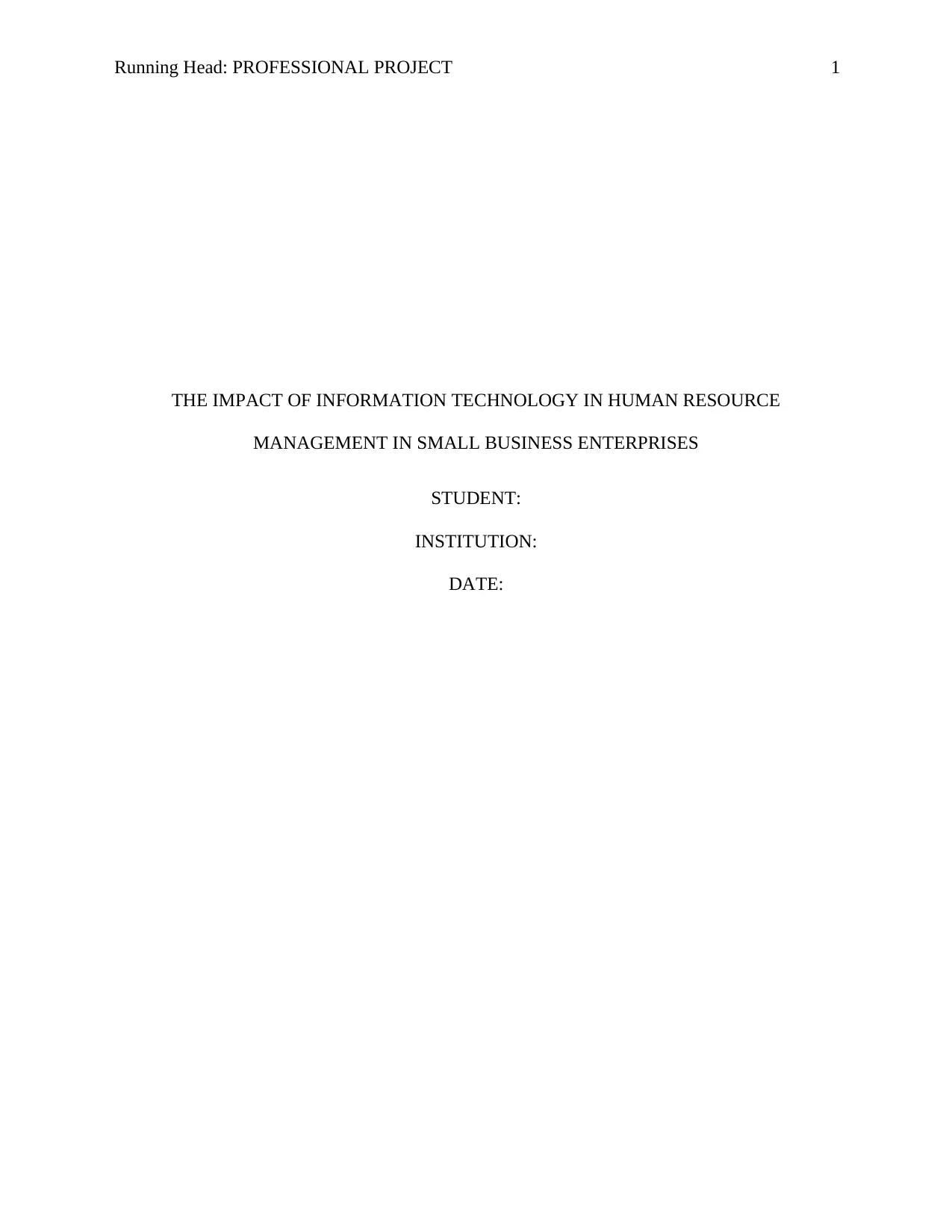
Running Head: PROFESSIONAL PROJECT 1
THE IMPACT OF INFORMATION TECHNOLOGY IN HUMAN RESOURCE
MANAGEMENT IN SMALL BUSINESS ENTERPRISES
STUDENT:
INSTITUTION:
DATE:
THE IMPACT OF INFORMATION TECHNOLOGY IN HUMAN RESOURCE
MANAGEMENT IN SMALL BUSINESS ENTERPRISES
STUDENT:
INSTITUTION:
DATE:
Paraphrase This Document
Need a fresh take? Get an instant paraphrase of this document with our AI Paraphraser
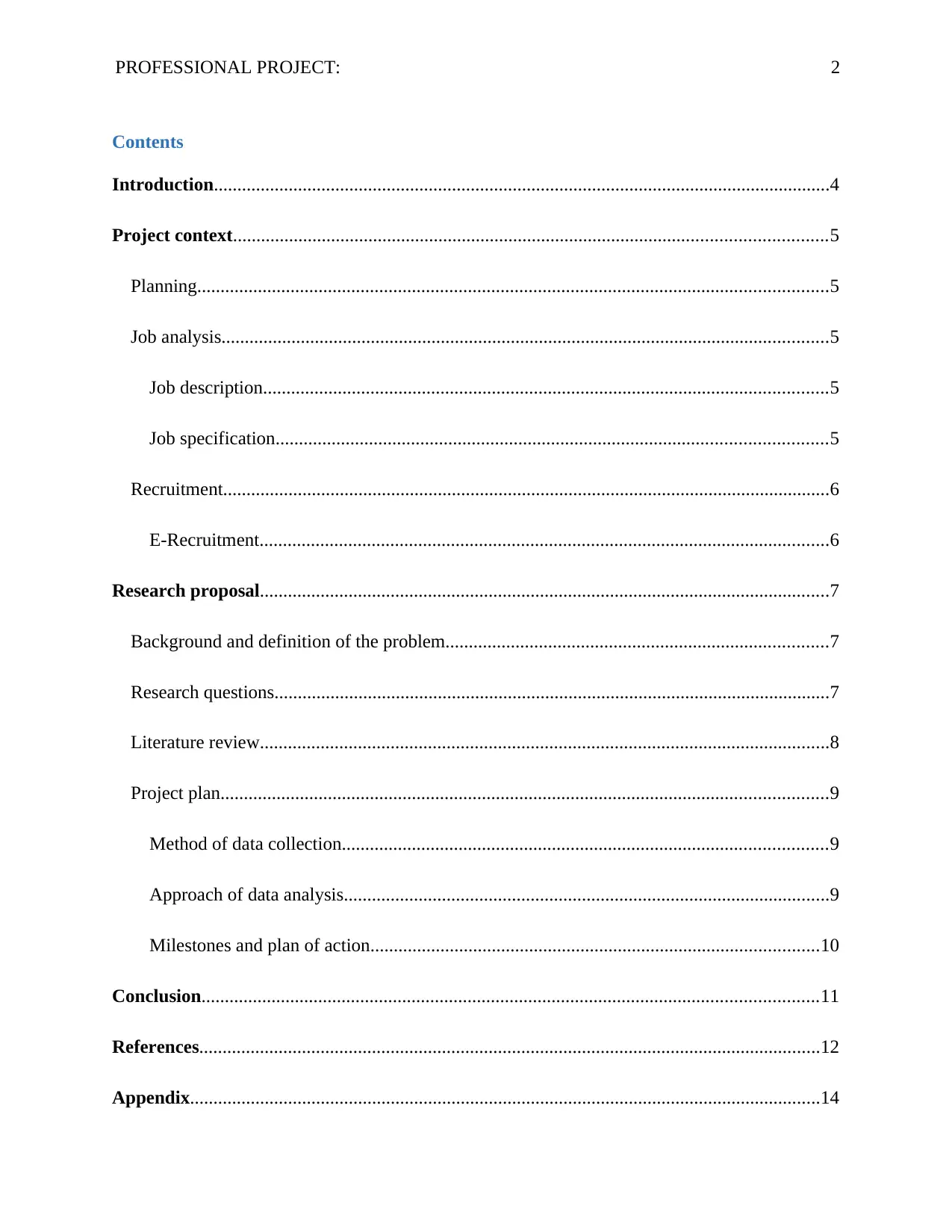
PROFESSIONAL PROJECT: 2
Contents
Introduction....................................................................................................................................4
Project context...............................................................................................................................5
Planning.......................................................................................................................................5
Job analysis..................................................................................................................................5
Job description.........................................................................................................................5
Job specification......................................................................................................................5
Recruitment..................................................................................................................................6
E-Recruitment..........................................................................................................................6
Research proposal..........................................................................................................................7
Background and definition of the problem..................................................................................7
Research questions.......................................................................................................................7
Literature review..........................................................................................................................8
Project plan..................................................................................................................................9
Method of data collection........................................................................................................9
Approach of data analysis........................................................................................................9
Milestones and plan of action................................................................................................10
Conclusion....................................................................................................................................11
References.....................................................................................................................................12
Appendix.......................................................................................................................................14
Contents
Introduction....................................................................................................................................4
Project context...............................................................................................................................5
Planning.......................................................................................................................................5
Job analysis..................................................................................................................................5
Job description.........................................................................................................................5
Job specification......................................................................................................................5
Recruitment..................................................................................................................................6
E-Recruitment..........................................................................................................................6
Research proposal..........................................................................................................................7
Background and definition of the problem..................................................................................7
Research questions.......................................................................................................................7
Literature review..........................................................................................................................8
Project plan..................................................................................................................................9
Method of data collection........................................................................................................9
Approach of data analysis........................................................................................................9
Milestones and plan of action................................................................................................10
Conclusion....................................................................................................................................11
References.....................................................................................................................................12
Appendix.......................................................................................................................................14
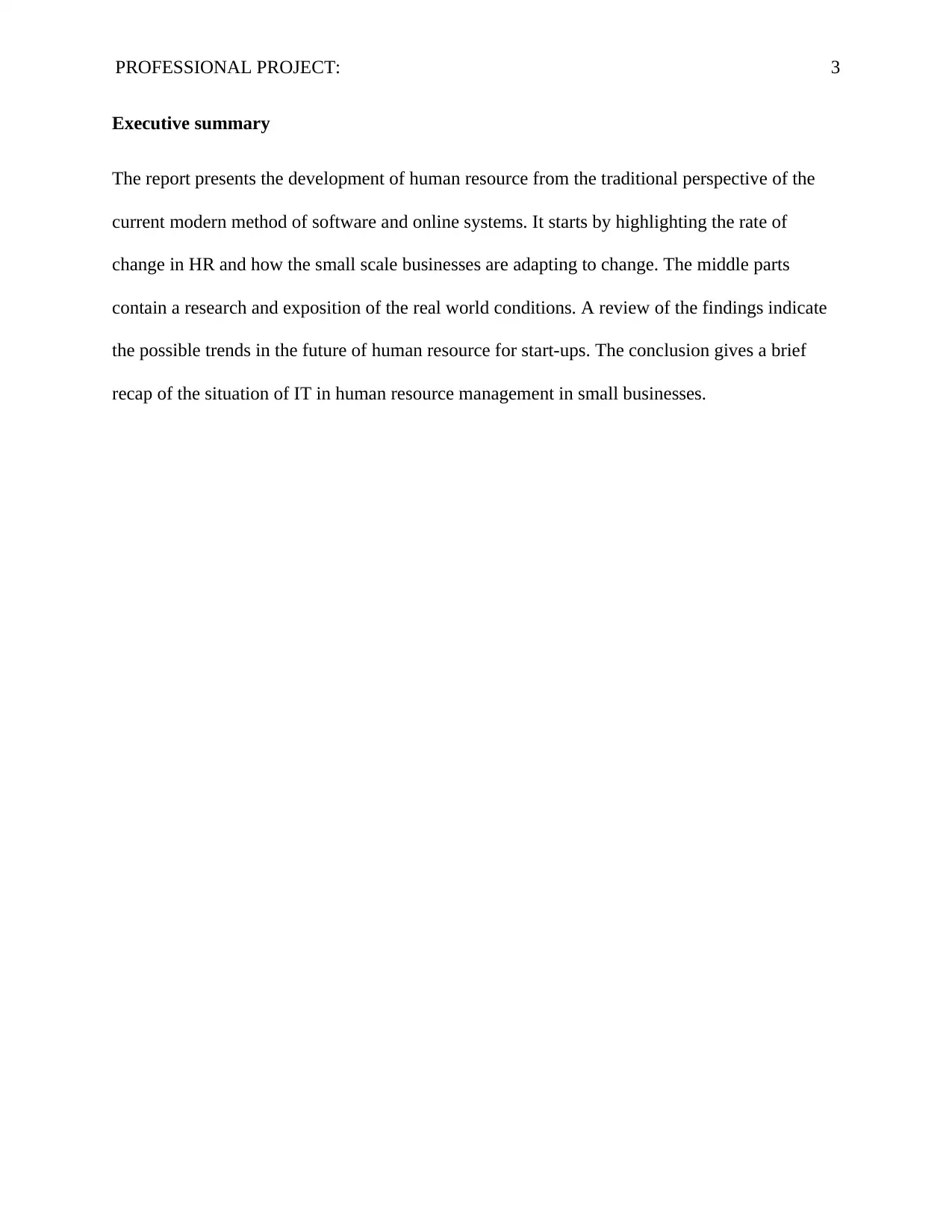
PROFESSIONAL PROJECT: 3
Executive summary
The report presents the development of human resource from the traditional perspective of the
current modern method of software and online systems. It starts by highlighting the rate of
change in HR and how the small scale businesses are adapting to change. The middle parts
contain a research and exposition of the real world conditions. A review of the findings indicate
the possible trends in the future of human resource for start-ups. The conclusion gives a brief
recap of the situation of IT in human resource management in small businesses.
Executive summary
The report presents the development of human resource from the traditional perspective of the
current modern method of software and online systems. It starts by highlighting the rate of
change in HR and how the small scale businesses are adapting to change. The middle parts
contain a research and exposition of the real world conditions. A review of the findings indicate
the possible trends in the future of human resource for start-ups. The conclusion gives a brief
recap of the situation of IT in human resource management in small businesses.
⊘ This is a preview!⊘
Do you want full access?
Subscribe today to unlock all pages.

Trusted by 1+ million students worldwide
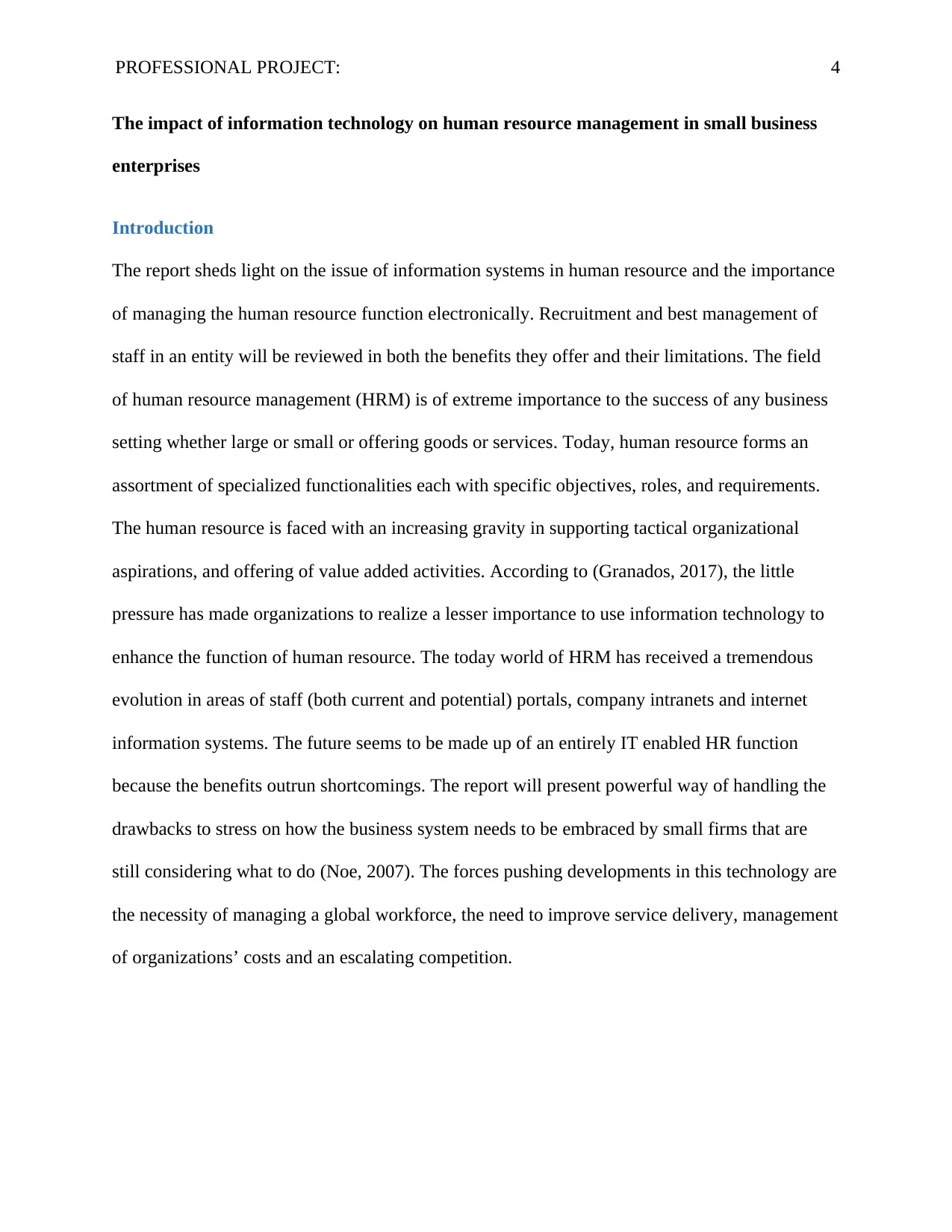
PROFESSIONAL PROJECT: 4
The impact of information technology on human resource management in small business
enterprises
Introduction
The report sheds light on the issue of information systems in human resource and the importance
of managing the human resource function electronically. Recruitment and best management of
staff in an entity will be reviewed in both the benefits they offer and their limitations. The field
of human resource management (HRM) is of extreme importance to the success of any business
setting whether large or small or offering goods or services. Today, human resource forms an
assortment of specialized functionalities each with specific objectives, roles, and requirements.
The human resource is faced with an increasing gravity in supporting tactical organizational
aspirations, and offering of value added activities. According to (Granados, 2017), the little
pressure has made organizations to realize a lesser importance to use information technology to
enhance the function of human resource. The today world of HRM has received a tremendous
evolution in areas of staff (both current and potential) portals, company intranets and internet
information systems. The future seems to be made up of an entirely IT enabled HR function
because the benefits outrun shortcomings. The report will present powerful way of handling the
drawbacks to stress on how the business system needs to be embraced by small firms that are
still considering what to do (Noe, 2007). The forces pushing developments in this technology are
the necessity of managing a global workforce, the need to improve service delivery, management
of organizations’ costs and an escalating competition.
The impact of information technology on human resource management in small business
enterprises
Introduction
The report sheds light on the issue of information systems in human resource and the importance
of managing the human resource function electronically. Recruitment and best management of
staff in an entity will be reviewed in both the benefits they offer and their limitations. The field
of human resource management (HRM) is of extreme importance to the success of any business
setting whether large or small or offering goods or services. Today, human resource forms an
assortment of specialized functionalities each with specific objectives, roles, and requirements.
The human resource is faced with an increasing gravity in supporting tactical organizational
aspirations, and offering of value added activities. According to (Granados, 2017), the little
pressure has made organizations to realize a lesser importance to use information technology to
enhance the function of human resource. The today world of HRM has received a tremendous
evolution in areas of staff (both current and potential) portals, company intranets and internet
information systems. The future seems to be made up of an entirely IT enabled HR function
because the benefits outrun shortcomings. The report will present powerful way of handling the
drawbacks to stress on how the business system needs to be embraced by small firms that are
still considering what to do (Noe, 2007). The forces pushing developments in this technology are
the necessity of managing a global workforce, the need to improve service delivery, management
of organizations’ costs and an escalating competition.
Paraphrase This Document
Need a fresh take? Get an instant paraphrase of this document with our AI Paraphraser
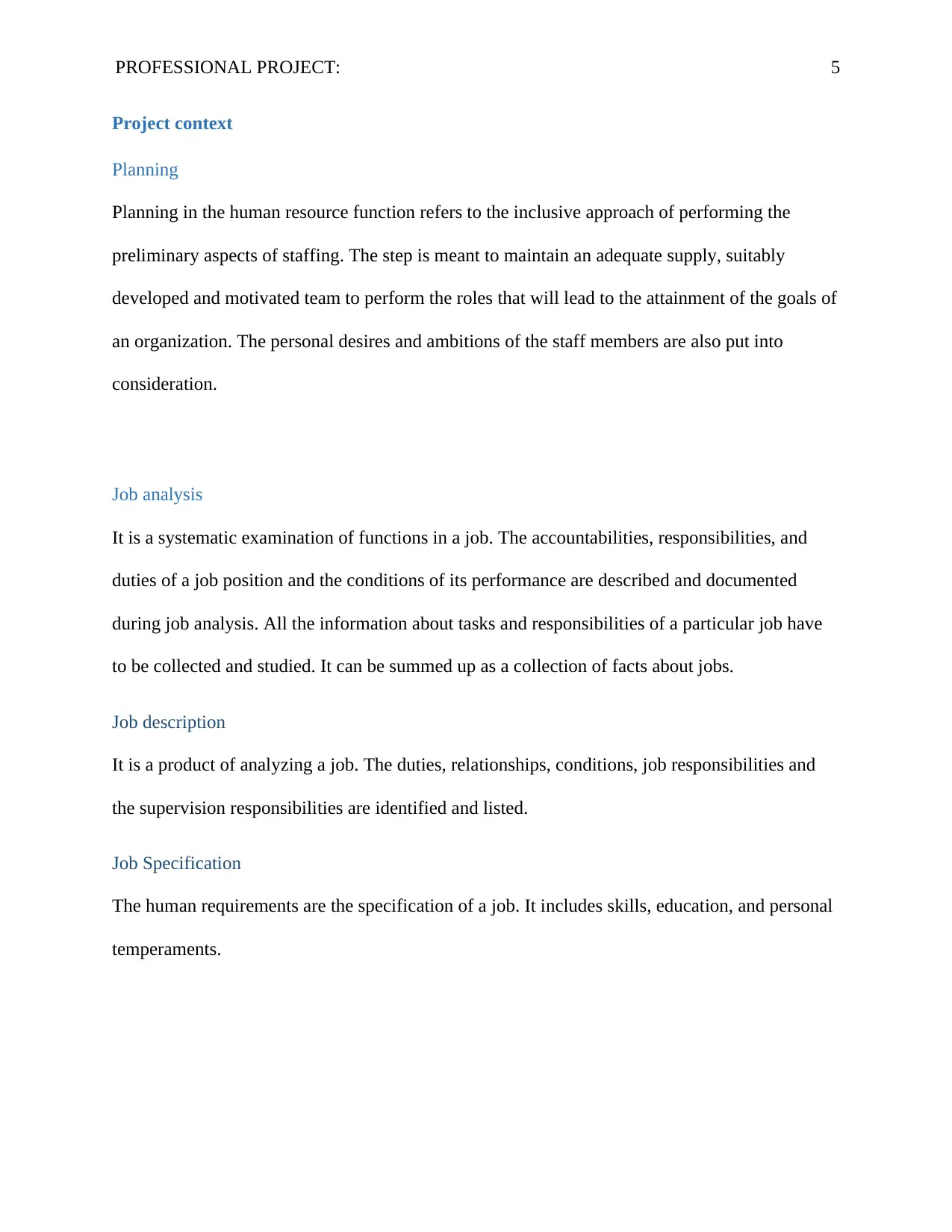
PROFESSIONAL PROJECT: 5
Project context
Planning
Planning in the human resource function refers to the inclusive approach of performing the
preliminary aspects of staffing. The step is meant to maintain an adequate supply, suitably
developed and motivated team to perform the roles that will lead to the attainment of the goals of
an organization. The personal desires and ambitions of the staff members are also put into
consideration.
Job analysis
It is a systematic examination of functions in a job. The accountabilities, responsibilities, and
duties of a job position and the conditions of its performance are described and documented
during job analysis. All the information about tasks and responsibilities of a particular job have
to be collected and studied. It can be summed up as a collection of facts about jobs.
Job description
It is a product of analyzing a job. The duties, relationships, conditions, job responsibilities and
the supervision responsibilities are identified and listed.
Job Specification
The human requirements are the specification of a job. It includes skills, education, and personal
temperaments.
Project context
Planning
Planning in the human resource function refers to the inclusive approach of performing the
preliminary aspects of staffing. The step is meant to maintain an adequate supply, suitably
developed and motivated team to perform the roles that will lead to the attainment of the goals of
an organization. The personal desires and ambitions of the staff members are also put into
consideration.
Job analysis
It is a systematic examination of functions in a job. The accountabilities, responsibilities, and
duties of a job position and the conditions of its performance are described and documented
during job analysis. All the information about tasks and responsibilities of a particular job have
to be collected and studied. It can be summed up as a collection of facts about jobs.
Job description
It is a product of analyzing a job. The duties, relationships, conditions, job responsibilities and
the supervision responsibilities are identified and listed.
Job Specification
The human requirements are the specification of a job. It includes skills, education, and personal
temperaments.
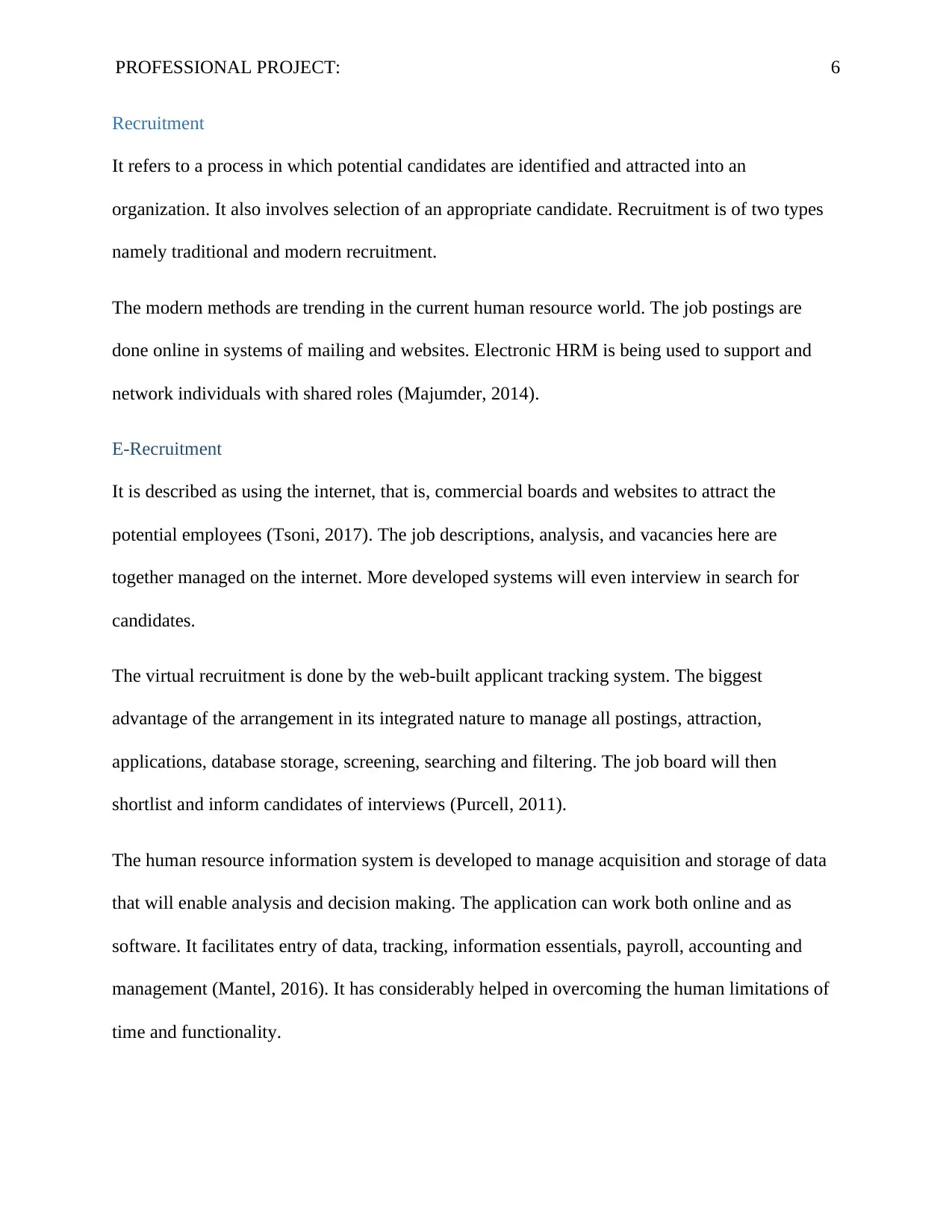
PROFESSIONAL PROJECT: 6
Recruitment
It refers to a process in which potential candidates are identified and attracted into an
organization. It also involves selection of an appropriate candidate. Recruitment is of two types
namely traditional and modern recruitment.
The modern methods are trending in the current human resource world. The job postings are
done online in systems of mailing and websites. Electronic HRM is being used to support and
network individuals with shared roles (Majumder, 2014).
E-Recruitment
It is described as using the internet, that is, commercial boards and websites to attract the
potential employees (Tsoni, 2017). The job descriptions, analysis, and vacancies here are
together managed on the internet. More developed systems will even interview in search for
candidates.
The virtual recruitment is done by the web-built applicant tracking system. The biggest
advantage of the arrangement in its integrated nature to manage all postings, attraction,
applications, database storage, screening, searching and filtering. The job board will then
shortlist and inform candidates of interviews (Purcell, 2011).
The human resource information system is developed to manage acquisition and storage of data
that will enable analysis and decision making. The application can work both online and as
software. It facilitates entry of data, tracking, information essentials, payroll, accounting and
management (Mantel, 2016). It has considerably helped in overcoming the human limitations of
time and functionality.
Recruitment
It refers to a process in which potential candidates are identified and attracted into an
organization. It also involves selection of an appropriate candidate. Recruitment is of two types
namely traditional and modern recruitment.
The modern methods are trending in the current human resource world. The job postings are
done online in systems of mailing and websites. Electronic HRM is being used to support and
network individuals with shared roles (Majumder, 2014).
E-Recruitment
It is described as using the internet, that is, commercial boards and websites to attract the
potential employees (Tsoni, 2017). The job descriptions, analysis, and vacancies here are
together managed on the internet. More developed systems will even interview in search for
candidates.
The virtual recruitment is done by the web-built applicant tracking system. The biggest
advantage of the arrangement in its integrated nature to manage all postings, attraction,
applications, database storage, screening, searching and filtering. The job board will then
shortlist and inform candidates of interviews (Purcell, 2011).
The human resource information system is developed to manage acquisition and storage of data
that will enable analysis and decision making. The application can work both online and as
software. It facilitates entry of data, tracking, information essentials, payroll, accounting and
management (Mantel, 2016). It has considerably helped in overcoming the human limitations of
time and functionality.
⊘ This is a preview!⊘
Do you want full access?
Subscribe today to unlock all pages.

Trusted by 1+ million students worldwide
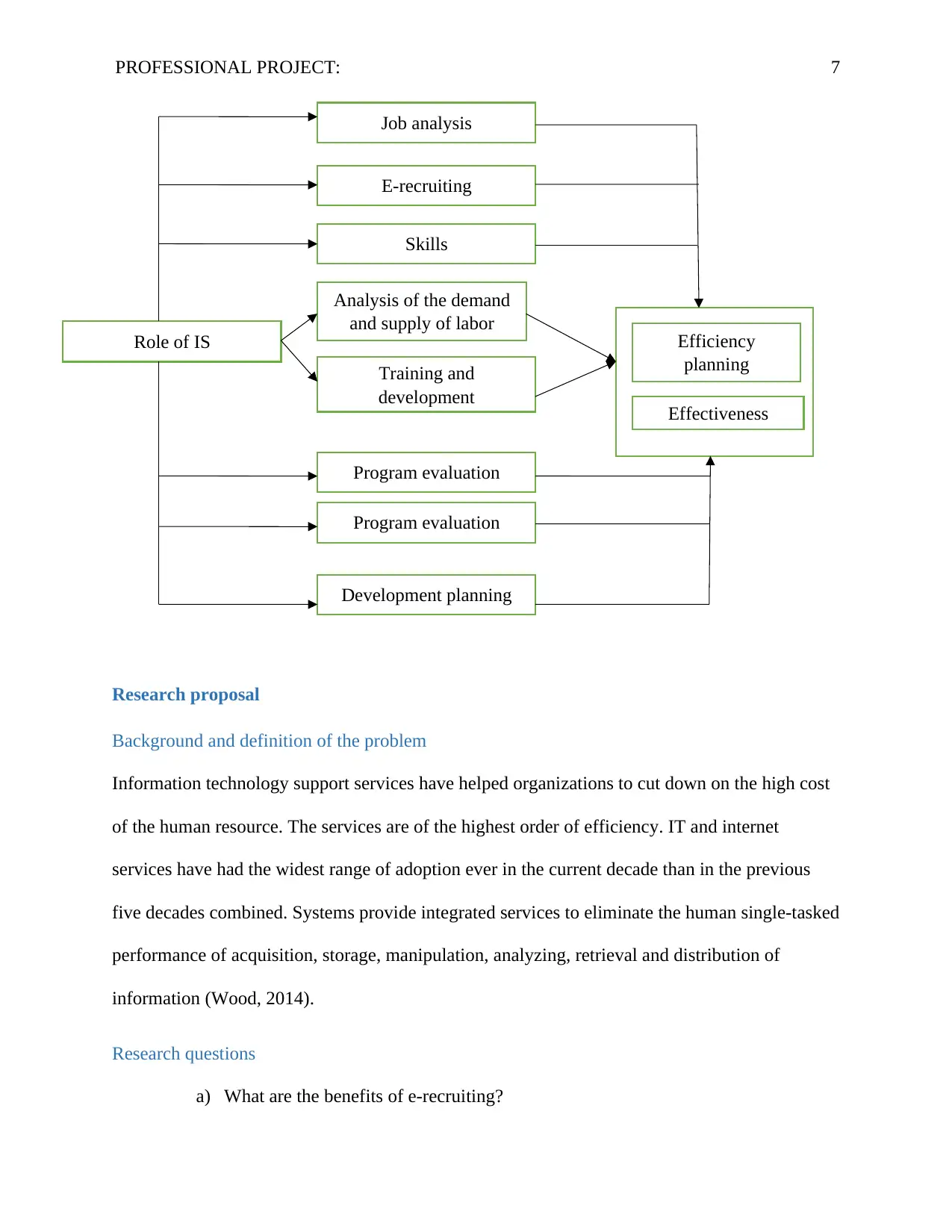
PROFESSIONAL PROJECT: 7
Research proposal
Background and definition of the problem
Information technology support services have helped organizations to cut down on the high cost
of the human resource. The services are of the highest order of efficiency. IT and internet
services have had the widest range of adoption ever in the current decade than in the previous
five decades combined. Systems provide integrated services to eliminate the human single-tasked
performance of acquisition, storage, manipulation, analyzing, retrieval and distribution of
information (Wood, 2014).
Research questions
a) What are the benefits of e-recruiting?
Job analysis
E-recruiting
Program evaluation
Effectiveness
planning
Skills
Analysis of the demand
and supply of labor
Training and
development
Development planning
Program evaluation
Efficiency
planning
Role of IS
Research proposal
Background and definition of the problem
Information technology support services have helped organizations to cut down on the high cost
of the human resource. The services are of the highest order of efficiency. IT and internet
services have had the widest range of adoption ever in the current decade than in the previous
five decades combined. Systems provide integrated services to eliminate the human single-tasked
performance of acquisition, storage, manipulation, analyzing, retrieval and distribution of
information (Wood, 2014).
Research questions
a) What are the benefits of e-recruiting?
Job analysis
E-recruiting
Program evaluation
Effectiveness
planning
Skills
Analysis of the demand
and supply of labor
Training and
development
Development planning
Program evaluation
Efficiency
planning
Role of IS
Paraphrase This Document
Need a fresh take? Get an instant paraphrase of this document with our AI Paraphraser
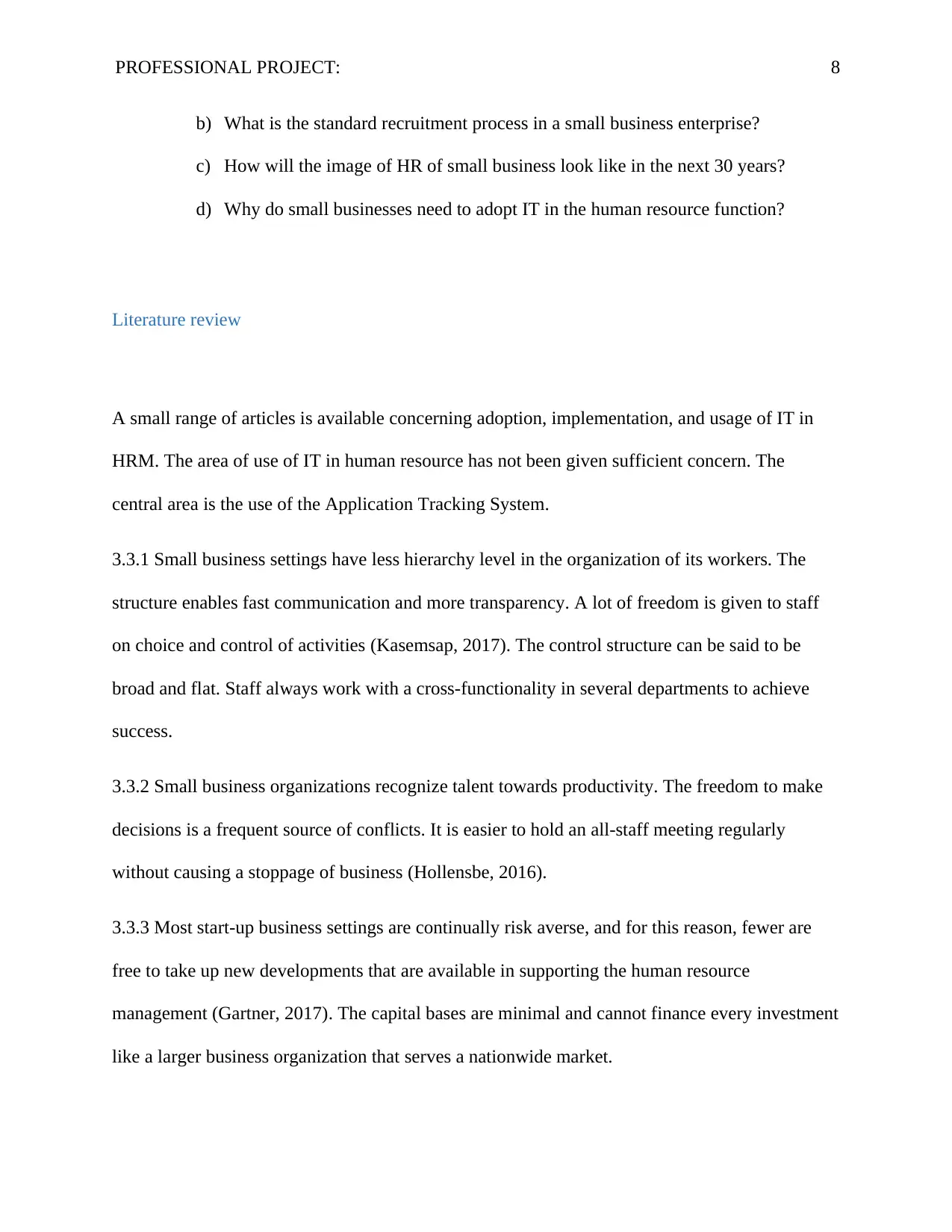
PROFESSIONAL PROJECT: 8
b) What is the standard recruitment process in a small business enterprise?
c) How will the image of HR of small business look like in the next 30 years?
d) Why do small businesses need to adopt IT in the human resource function?
Literature review
A small range of articles is available concerning adoption, implementation, and usage of IT in
HRM. The area of use of IT in human resource has not been given sufficient concern. The
central area is the use of the Application Tracking System.
3.3.1 Small business settings have less hierarchy level in the organization of its workers. The
structure enables fast communication and more transparency. A lot of freedom is given to staff
on choice and control of activities (Kasemsap, 2017). The control structure can be said to be
broad and flat. Staff always work with a cross-functionality in several departments to achieve
success.
3.3.2 Small business organizations recognize talent towards productivity. The freedom to make
decisions is a frequent source of conflicts. It is easier to hold an all-staff meeting regularly
without causing a stoppage of business (Hollensbe, 2016).
3.3.3 Most start-up business settings are continually risk averse, and for this reason, fewer are
free to take up new developments that are available in supporting the human resource
management (Gartner, 2017). The capital bases are minimal and cannot finance every investment
like a larger business organization that serves a nationwide market.
b) What is the standard recruitment process in a small business enterprise?
c) How will the image of HR of small business look like in the next 30 years?
d) Why do small businesses need to adopt IT in the human resource function?
Literature review
A small range of articles is available concerning adoption, implementation, and usage of IT in
HRM. The area of use of IT in human resource has not been given sufficient concern. The
central area is the use of the Application Tracking System.
3.3.1 Small business settings have less hierarchy level in the organization of its workers. The
structure enables fast communication and more transparency. A lot of freedom is given to staff
on choice and control of activities (Kasemsap, 2017). The control structure can be said to be
broad and flat. Staff always work with a cross-functionality in several departments to achieve
success.
3.3.2 Small business organizations recognize talent towards productivity. The freedom to make
decisions is a frequent source of conflicts. It is easier to hold an all-staff meeting regularly
without causing a stoppage of business (Hollensbe, 2016).
3.3.3 Most start-up business settings are continually risk averse, and for this reason, fewer are
free to take up new developments that are available in supporting the human resource
management (Gartner, 2017). The capital bases are minimal and cannot finance every investment
like a larger business organization that serves a nationwide market.
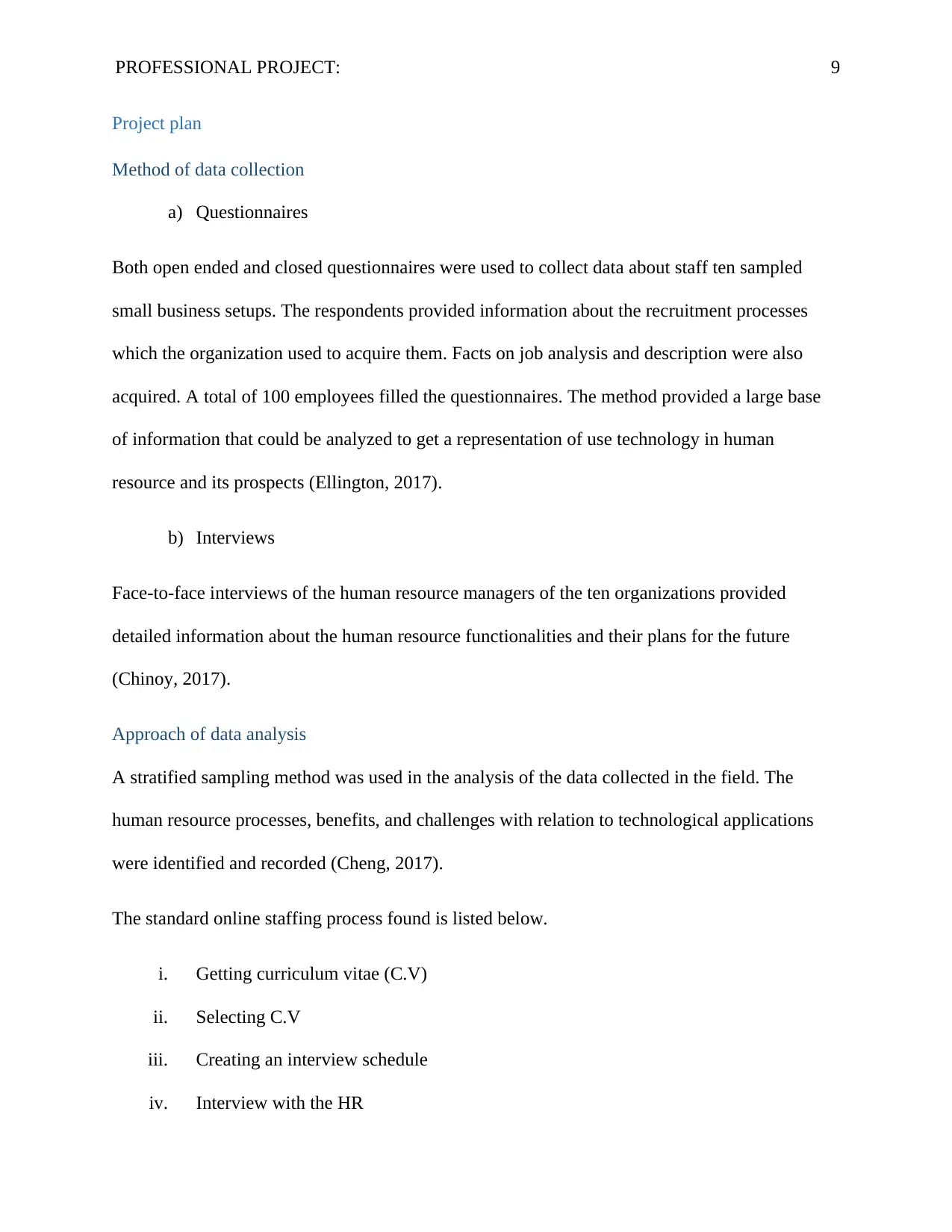
PROFESSIONAL PROJECT: 9
Project plan
Method of data collection
a) Questionnaires
Both open ended and closed questionnaires were used to collect data about staff ten sampled
small business setups. The respondents provided information about the recruitment processes
which the organization used to acquire them. Facts on job analysis and description were also
acquired. A total of 100 employees filled the questionnaires. The method provided a large base
of information that could be analyzed to get a representation of use technology in human
resource and its prospects (Ellington, 2017).
b) Interviews
Face-to-face interviews of the human resource managers of the ten organizations provided
detailed information about the human resource functionalities and their plans for the future
(Chinoy, 2017).
Approach of data analysis
A stratified sampling method was used in the analysis of the data collected in the field. The
human resource processes, benefits, and challenges with relation to technological applications
were identified and recorded (Cheng, 2017).
The standard online staffing process found is listed below.
i. Getting curriculum vitae (C.V)
ii. Selecting C.V
iii. Creating an interview schedule
iv. Interview with the HR
Project plan
Method of data collection
a) Questionnaires
Both open ended and closed questionnaires were used to collect data about staff ten sampled
small business setups. The respondents provided information about the recruitment processes
which the organization used to acquire them. Facts on job analysis and description were also
acquired. A total of 100 employees filled the questionnaires. The method provided a large base
of information that could be analyzed to get a representation of use technology in human
resource and its prospects (Ellington, 2017).
b) Interviews
Face-to-face interviews of the human resource managers of the ten organizations provided
detailed information about the human resource functionalities and their plans for the future
(Chinoy, 2017).
Approach of data analysis
A stratified sampling method was used in the analysis of the data collected in the field. The
human resource processes, benefits, and challenges with relation to technological applications
were identified and recorded (Cheng, 2017).
The standard online staffing process found is listed below.
i. Getting curriculum vitae (C.V)
ii. Selecting C.V
iii. Creating an interview schedule
iv. Interview with the HR
⊘ This is a preview!⊘
Do you want full access?
Subscribe today to unlock all pages.

Trusted by 1+ million students worldwide
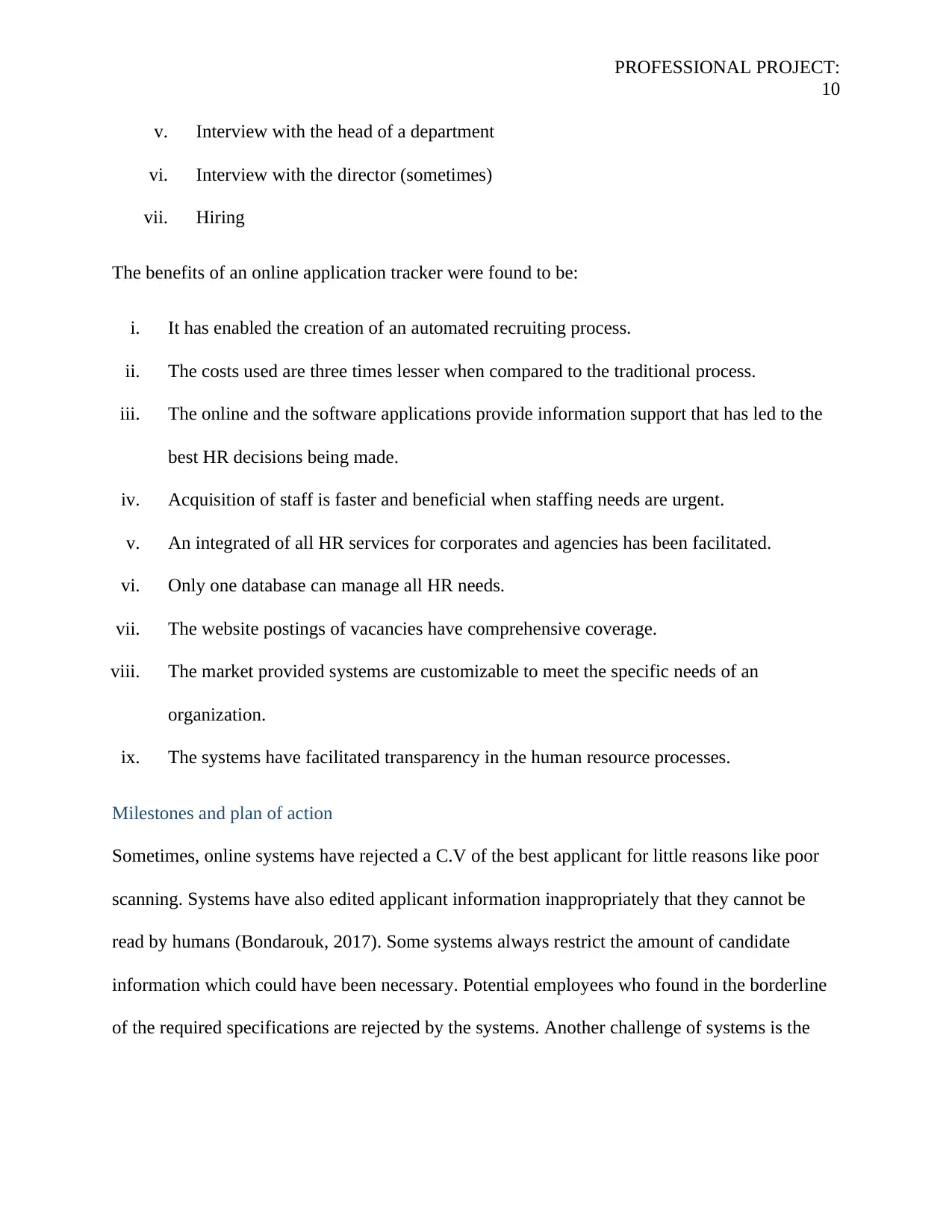
PROFESSIONAL PROJECT:
10
v. Interview with the head of a department
vi. Interview with the director (sometimes)
vii. Hiring
The benefits of an online application tracker were found to be:
i. It has enabled the creation of an automated recruiting process.
ii. The costs used are three times lesser when compared to the traditional process.
iii. The online and the software applications provide information support that has led to the
best HR decisions being made.
iv. Acquisition of staff is faster and beneficial when staffing needs are urgent.
v. An integrated of all HR services for corporates and agencies has been facilitated.
vi. Only one database can manage all HR needs.
vii. The website postings of vacancies have comprehensive coverage.
viii. The market provided systems are customizable to meet the specific needs of an
organization.
ix. The systems have facilitated transparency in the human resource processes.
Milestones and plan of action
Sometimes, online systems have rejected a C.V of the best applicant for little reasons like poor
scanning. Systems have also edited applicant information inappropriately that they cannot be
read by humans (Bondarouk, 2017). Some systems always restrict the amount of candidate
information which could have been necessary. Potential employees who found in the borderline
of the required specifications are rejected by the systems. Another challenge of systems is the
10
v. Interview with the head of a department
vi. Interview with the director (sometimes)
vii. Hiring
The benefits of an online application tracker were found to be:
i. It has enabled the creation of an automated recruiting process.
ii. The costs used are three times lesser when compared to the traditional process.
iii. The online and the software applications provide information support that has led to the
best HR decisions being made.
iv. Acquisition of staff is faster and beneficial when staffing needs are urgent.
v. An integrated of all HR services for corporates and agencies has been facilitated.
vi. Only one database can manage all HR needs.
vii. The website postings of vacancies have comprehensive coverage.
viii. The market provided systems are customizable to meet the specific needs of an
organization.
ix. The systems have facilitated transparency in the human resource processes.
Milestones and plan of action
Sometimes, online systems have rejected a C.V of the best applicant for little reasons like poor
scanning. Systems have also edited applicant information inappropriately that they cannot be
read by humans (Bondarouk, 2017). Some systems always restrict the amount of candidate
information which could have been necessary. Potential employees who found in the borderline
of the required specifications are rejected by the systems. Another challenge of systems is the
Paraphrase This Document
Need a fresh take? Get an instant paraphrase of this document with our AI Paraphraser
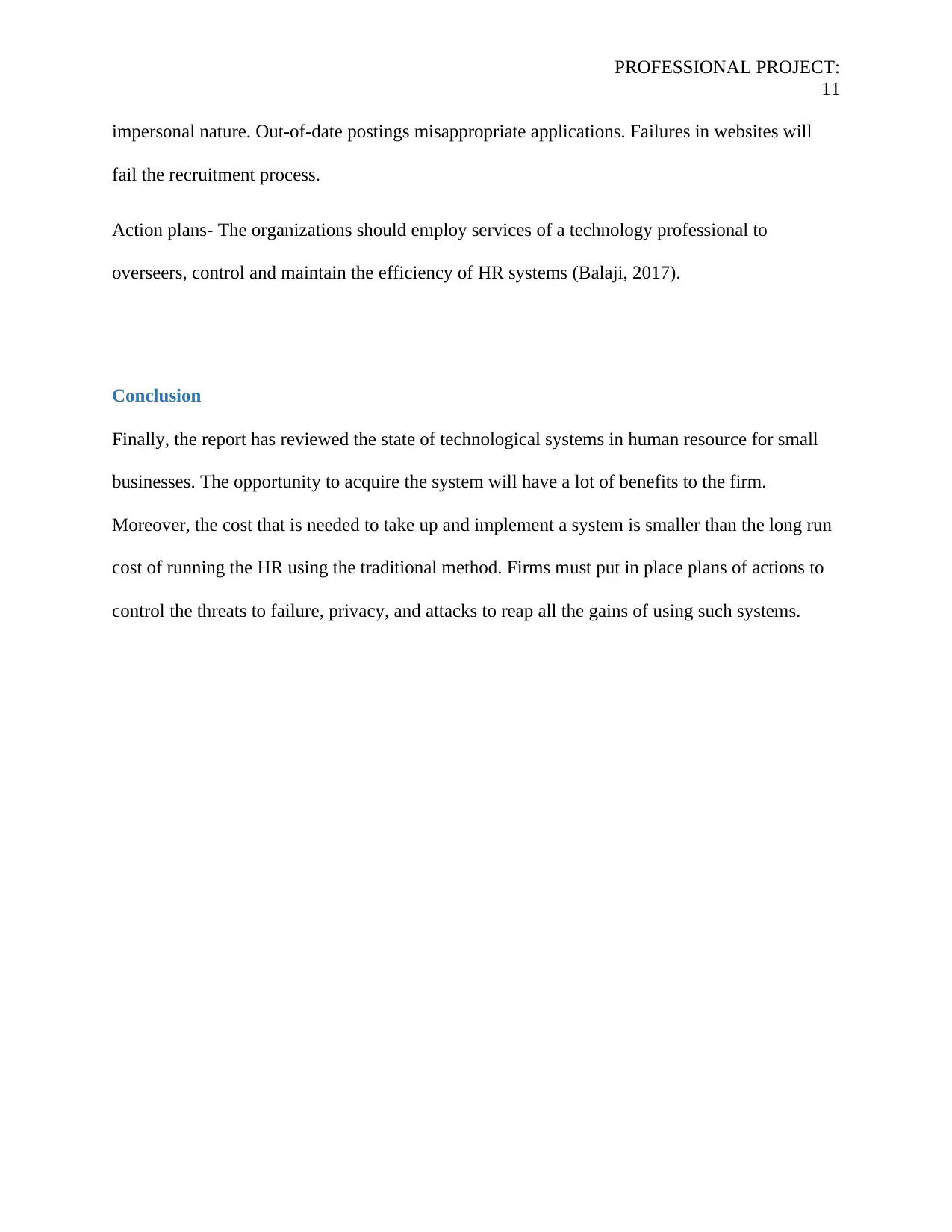
PROFESSIONAL PROJECT:
11
impersonal nature. Out-of-date postings misappropriate applications. Failures in websites will
fail the recruitment process.
Action plans- The organizations should employ services of a technology professional to
overseers, control and maintain the efficiency of HR systems (Balaji, 2017).
Conclusion
Finally, the report has reviewed the state of technological systems in human resource for small
businesses. The opportunity to acquire the system will have a lot of benefits to the firm.
Moreover, the cost that is needed to take up and implement a system is smaller than the long run
cost of running the HR using the traditional method. Firms must put in place plans of actions to
control the threats to failure, privacy, and attacks to reap all the gains of using such systems.
11
impersonal nature. Out-of-date postings misappropriate applications. Failures in websites will
fail the recruitment process.
Action plans- The organizations should employ services of a technology professional to
overseers, control and maintain the efficiency of HR systems (Balaji, 2017).
Conclusion
Finally, the report has reviewed the state of technological systems in human resource for small
businesses. The opportunity to acquire the system will have a lot of benefits to the firm.
Moreover, the cost that is needed to take up and implement a system is smaller than the long run
cost of running the HR using the traditional method. Firms must put in place plans of actions to
control the threats to failure, privacy, and attacks to reap all the gains of using such systems.
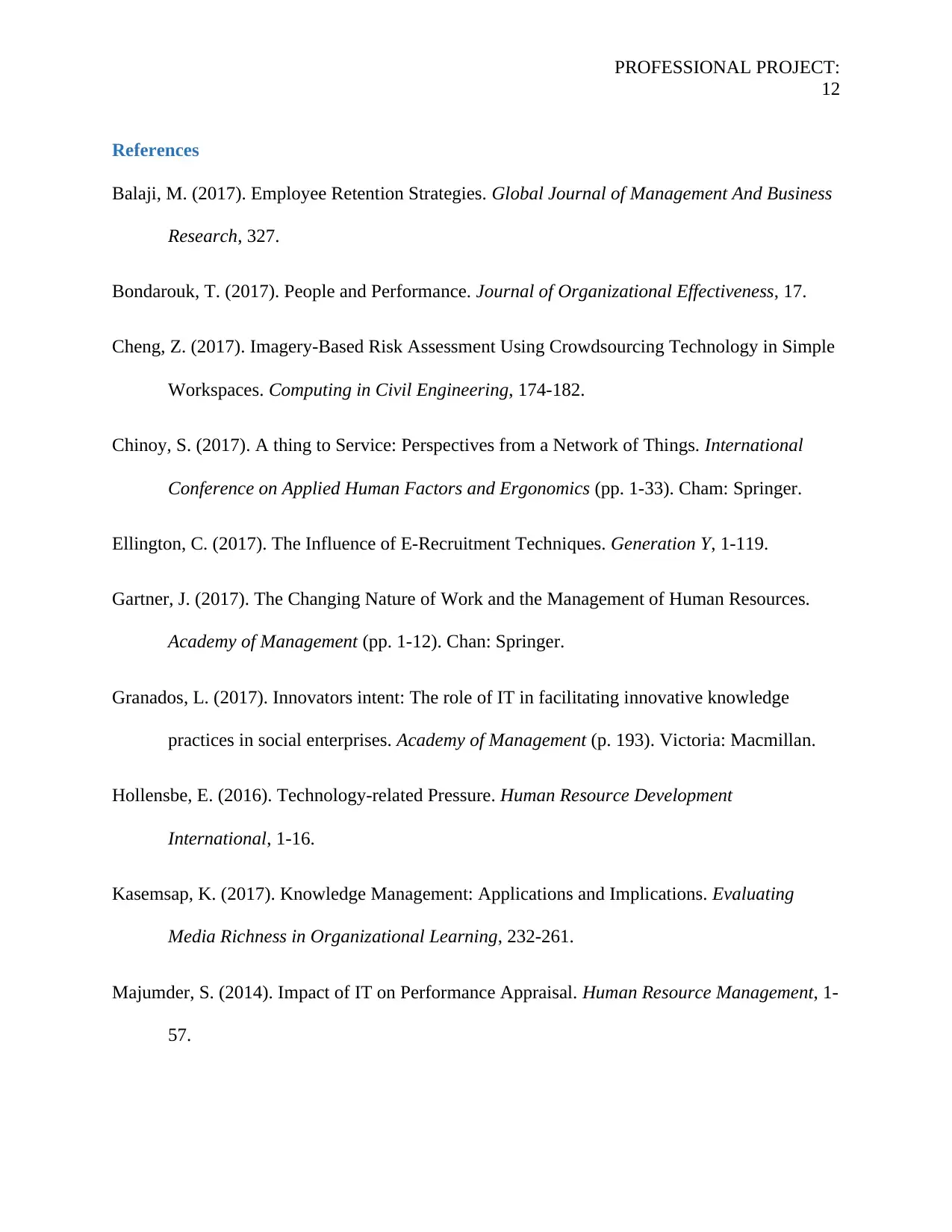
PROFESSIONAL PROJECT:
12
References
Balaji, M. (2017). Employee Retention Strategies. Global Journal of Management And Business
Research, 327.
Bondarouk, T. (2017). People and Performance. Journal of Organizational Effectiveness, 17.
Cheng, Z. (2017). Imagery-Based Risk Assessment Using Crowdsourcing Technology in Simple
Workspaces. Computing in Civil Engineering, 174-182.
Chinoy, S. (2017). A thing to Service: Perspectives from a Network of Things. International
Conference on Applied Human Factors and Ergonomics (pp. 1-33). Cham: Springer.
Ellington, C. (2017). The Influence of E-Recruitment Techniques. Generation Y, 1-119.
Gartner, J. (2017). The Changing Nature of Work and the Management of Human Resources.
Academy of Management (pp. 1-12). Chan: Springer.
Granados, L. (2017). Innovators intent: The role of IT in facilitating innovative knowledge
practices in social enterprises. Academy of Management (p. 193). Victoria: Macmillan.
Hollensbe, E. (2016). Technology-related Pressure. Human Resource Development
International, 1-16.
Kasemsap, K. (2017). Knowledge Management: Applications and Implications. Evaluating
Media Richness in Organizational Learning, 232-261.
Majumder, S. (2014). Impact of IT on Performance Appraisal. Human Resource Management, 1-
57.
12
References
Balaji, M. (2017). Employee Retention Strategies. Global Journal of Management And Business
Research, 327.
Bondarouk, T. (2017). People and Performance. Journal of Organizational Effectiveness, 17.
Cheng, Z. (2017). Imagery-Based Risk Assessment Using Crowdsourcing Technology in Simple
Workspaces. Computing in Civil Engineering, 174-182.
Chinoy, S. (2017). A thing to Service: Perspectives from a Network of Things. International
Conference on Applied Human Factors and Ergonomics (pp. 1-33). Cham: Springer.
Ellington, C. (2017). The Influence of E-Recruitment Techniques. Generation Y, 1-119.
Gartner, J. (2017). The Changing Nature of Work and the Management of Human Resources.
Academy of Management (pp. 1-12). Chan: Springer.
Granados, L. (2017). Innovators intent: The role of IT in facilitating innovative knowledge
practices in social enterprises. Academy of Management (p. 193). Victoria: Macmillan.
Hollensbe, E. (2016). Technology-related Pressure. Human Resource Development
International, 1-16.
Kasemsap, K. (2017). Knowledge Management: Applications and Implications. Evaluating
Media Richness in Organizational Learning, 232-261.
Majumder, S. (2014). Impact of IT on Performance Appraisal. Human Resource Management, 1-
57.
⊘ This is a preview!⊘
Do you want full access?
Subscribe today to unlock all pages.

Trusted by 1+ million students worldwide
1 out of 14
Related Documents
Your All-in-One AI-Powered Toolkit for Academic Success.
+13062052269
info@desklib.com
Available 24*7 on WhatsApp / Email
![[object Object]](/_next/static/media/star-bottom.7253800d.svg)
Unlock your academic potential
Copyright © 2020–2025 A2Z Services. All Rights Reserved. Developed and managed by ZUCOL.





